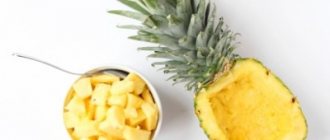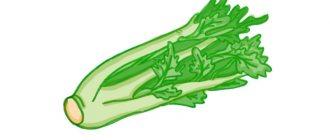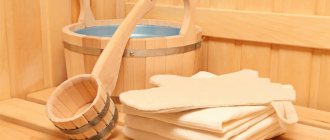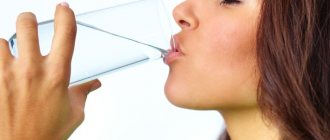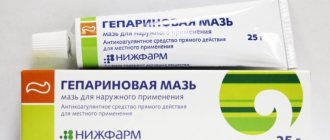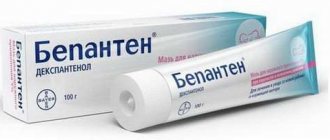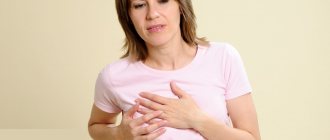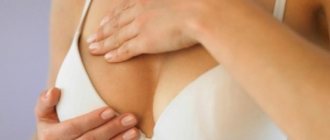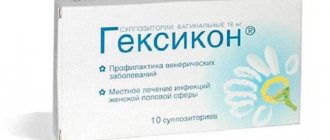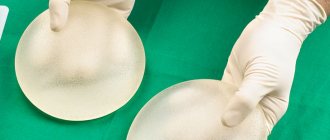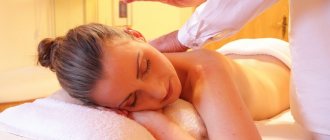Atopic dermatitis is a chronic disease of an allergenic nature with skin manifestations. Most often, the first signs of the disease appear in childhood, before the age of three. Sometimes no further signs of pathology occur during life. When exposed to provocateurs, as well as during periods of greatest weakening of the body, the disease can once again worsen; atopic dermatitis is often observed in a nursing mother. What are the causes of the disease, how to distinguish it from other skin pathologies? Diagnosis and treatment of atopic dermatitis sometimes pose difficulties due to the ambiguous nature of the disease and the similarity of the clinical picture with other processes.
Reasons for appearance
It is a recognized fact: atopic dermatitis has a genetic basis. Most likely, one of your close relatives suffered from various types of allergic diseases: bronchial asthma, hay fever, etc. And this feature of the immune system’s response was passed on to the woman.
Atopic dermatitis is not a skin disease; it only appears on the skin. This is a systemic pathology that reflects the body’s response to the entry of certain substances into it.
The essence of the skin manifestations of atopic dermatitis is as follows:
- One day, a woman’s body (perhaps when she was still in utero with her mother) receives substances that are perceived as foreign and are remembered with an immune response.
- When they are received again, he responds accordingly. For example, a specific reaction: gneiss appears in infancy or a rash in skin folds.
- And so every time, contact with a pathogen causes skin manifestations.
And even those women who claim that they never had signs of this disease simply do not remember it. By the age of one year, 99% of all of them had lesions on the cheeks. Often called “diathesis”, it has been mistaken for miliaria in skin folds. Already in adult life, if there was no contact with the allergen and other provoking situations (stress, hormonal changes, etc.), atopic dermatitis may not manifest itself. Any substance can be a provocateur: dust, food particles, pollen; often the “culprit” cannot be found.
Factors that contribute to the manifestation of pathology after childbirth:
- Frequent infectious diseases before and during pregnancy.
- Incorrect, excess caloric and allergenic foods for a long period of time.
- Diseases of the gastrointestinal tract.
- Stressful situations.
- Polluted environment.
- Hormonal changes during pregnancy and childbirth.
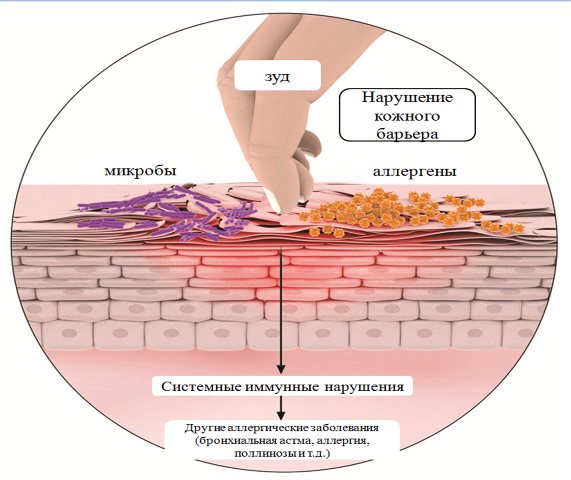
Potential threat to mother and baby
The wrap has virtually no negative impact on a woman or child. But still, during lactation you should be more careful about the components of the products used, giving preference to natural products, for example, coffee or salt.
Caution should be exercised if a wrap after childbirth is performed on a nursing woman without a previous allergy test in the salon, or if she independently carries out the procedure at home.
If a girl knows that she is developing an allergic reaction to such creams and ointments, as well as to certain products, such as honey, she should not use them. Even application to intact skin can cause hypersensitivity up to the development of anaphylactic shock, which poses a real threat to life.
As for the baby, it is necessary to exclude the moment when the drug/composition enters the oral cavity during sucking. Therefore, it is necessary to wash the breasts thoroughly or not touch them at all. The likelihood that a synthetic cream or a self-prepared mass will be absorbed in such quantities that, after systemic absorption, it will still pass into breast milk is extremely small.
How to recognize
Atopic dermatitis during lactation and at any other period of life has the same manifestations. The problem is that this pathology is often indistinguishable from eczema, allergies and some other diseases. You can identify it by the following signs.
| Sign | Causes |
| Redness | This symptom is always present. In certain places, the skin changes its color, most often this is observed on the flexor surface of the arms (elbows), in the temples and forehead, the back of the head at the border with hair growth, on the back of the hands and feet, wrists, and neck. The epidermis and dermis acquire a reddish color, then the shade may become more saturated. |
| Itching | Often this symptom occurs earlier than others, and only after constant scratching do red spots appear. Sometimes the itching is so significant that it brings considerable discomfort to the woman. The intensity does not depend on the time of day; it increases in winter and is virtually absent in summer and spring. If an allergen is identified, then upon contact with it, the itching also becomes more disturbing. |
| Dryness | The most common location of the pathology tends to be excessively dry, even some peeling. Timely use of moisturizing creams and maintaining a normal indoor microclimate help avoid exacerbations. |
| Accession of infection | Constant scratching of the affected areas leads to the appearance of crusts on the skin, and the epidermis begins to harden. If you do not use protective creams that will relieve the main manifestations of the disease, then an infection may develop over time. Inflammation may well be caused by opportunistic bacteria, which are normally present on the human body. When infected, the discharge from wounds (which are formed from scratching) becomes yellowish in color, and the amount may be small. Fungal infection of the ulcerated areas is also possible. |
What time can you start?
Many women are interested in when they can do body wraps after childbirth. After all, many people think about this even during pregnancy. The postpartum period lasts six to eight weeks after birth. Even if the pregnancy and birth of the baby passed without complications, it is better to leave this time for the body to heal itself.
In cases where a cesarean section was performed, you should wait until the postoperative wound has completely healed.
When applying various components to the abdominal area, if healing is not complete, infection may occur, followed by other complications.
In case of exacerbation of chronic pathology, one should wait for final remission.
Diagnostics
A correct and timely diagnosis allows you to get rid of the disease in the shortest possible time. It is advisable that every woman knows what health issues she had in childhood. Atopic dermatitis always has its first manifestation before the age of three years. If you notice itching, redness and other symptoms of pathology, you should consult a dermatologist. After a thorough examination, conversation and some additional research, he will be able to establish the most likely diagnosis. If necessary, a consultation with an allergist can be scheduled.
Atopic dermatitis does not have specific laboratory tests to confirm it, so the diagnosis is established mostly from the clinical picture and history of the disease. The only test that has any additional significance is blood testing for immunoglobulins E. They increase when the body is highly predisposed to various allergic diseases.
So, the diagnosis of atopic dermatitis is established if the following criteria are present:
- itching, eczema-like skin lesions;
- hereditary predisposition to increased immune reactivity (bronchial asthma, rhinitis in relatives and others);
- the first manifestation of the disease in childhood.
There are also some additional criteria, for example, recurrent conjunctivitis, nipple eczema, dry entire skin, cheilitis, cracks behind the ears and many others.
It is important to distinguish atopic dermatitis, including in a nursing mother, from other skin diseases. Most often it is necessary to carry out differential diagnosis with psoriasis, eczema, contact allergies, seborrheic dermatitis, immunodeficiency conditions, scabies (scabies) and some others.
Treatment for hepatitis B
Therapy for atopic dermatitis involves turning off contact with the allergen, if it is identified and this is possible. The diet is also adjusted to exclude foods that may aggravate the pathology.
Various ointments and creams are popular, but their use should be taken with caution: there is a high risk of not only the negative effects of the hormones that make up most of them, but there is also a possibility of sensitization of the baby’s body and the development of allergies. After all, if the mother has atopy, then the child is also 40-60% susceptible to it, and if both parents have allergic diseases, the risk increases to 80%.
Medications
Treatment of dermatitis during breastfeeding with any medications is possible only as prescribed by a doctor. A woman can only use various nourishing and moisturizing creams on her own. These can be products from any manufacturer that provide a significant effect with regular use. They should be used without waiting for an exacerbation, but regularly, especially in dry and cold climates. These include:
- "Bepanten", "Dexpanthenol". Can be used for healing and accelerating tissue regeneration in areas of scratching. They are also used during breastfeeding. Radevit ointment is interesting and sometimes very effective; it contains vitamins A, D and E, which are necessary to maintain normal skin condition. "Protopic" can be used during breastfeeding; it is one of the popular drugs for the treatment of dermatitis, even in children.
- Itching can be eliminated only by using ointments with a hormonal component. Their use should only be on the advice of a doctor. It may be necessary to express breast milk for a while without giving it to the baby in order to exclude the influence of these substances on him. The most popular medications are: Dermovate, Skin Cap, Flucinar and others. When using hormonal ointments, you should stop taking them correctly so that dependence does not arise and “rebound” syndrome does not form. To do this, as the symptoms decrease, they should be diluted 1:1, then 1:2, 1:3 with regular baby cream.
- Antihistamine tablets or ointments with a similar effect. However, their use during breastfeeding should be limited and used only as prescribed by a doctor for a short period.
Also, during the treatment process, you can take various herbal baths, for example, with chamomile, celandine or calendula.
Diet
For several months after giving birth, a woman adheres to a hypoallergenic diet so as not to irritate the gastrointestinal tract and other systems in the baby. If atopic dermatitis occurs, the following rules should be followed:
- You should not include in your diet citrus fruits, chocolate, nuts, any confectionery, pickled and smoked foods, semi-finished products and products containing large amounts of preservatives and dyes (usually all of them have a long shelf life).
- In small quantities and observing your own reaction, you can include milk and fatty foods (rich soups, pork). Orange and yellow colored fruits and vegetables, chicken and chicken products are also best limited in the diet.
- Lean meat (for example, beef, rabbit, etc.) and all types of cereals are allowed. You can eat vegetables and fruits of dim colors, as well as dry biscuits without additives (for example, crackers and crackers).
What types of facial cosmetic procedures can be done during breastfeeding?
Despite the fact that some types of peeling are prohibited for nursing women, there are still procedures that do not harm the baby and mother, and their effect is good .
Mechanical cleaning
This is an effective method of cleansing the face, but quite painful, since the skin is exposed to tools and fingers, but without the use of chemicals.
We recommend: Types of anti-aging exfoliants: what is more effective for the skin - yellow peeling or TCA?
Mechanical cleaning does the following::
- removes dead epithelial cells and excess sebum;
- improves blood circulation;
- has a micromassage effect.
As a result, the skin becomes clean, smooth and takes on a pleasant, healthy tone.
Watch a video about how the mechanical facial cleansing procedure goes:
Ultrasonic
This type of cleansing is usually painless, but breastfeeding women have sensitive skin and may experience slight discomfort. Ultrasound affects only the upper layers of the skin and is absolutely harmless .
During ultrasonic cleaning, the following occurs:
- dead cells are gently removed;
- sebaceous plugs and comedones are destroyed, come to the surface, after which the cosmetologist removes them;
- cellular metabolism is enhanced.
The result is healthy skin without oily shine, blackheads and flaking.
Below is an interesting video about ultrasonic facial cleansing:
Milk and almond
Milk peeling is as safe as possible for a nursing mother . Lactic acid, which is part of it, is also present in skin cells, so it is familiar to the body and the risk of allergies is minimized.
This peeling gives the following effect:
- exfoliates dead skin cells;
- moisturizes;
- has an anti-aging effect, makes wrinkles less noticeable;
- increases skin sensitivity to creams.
Almond peeling is also safe for women and infants. It has a bactericidal, cleansing and antioxidant effect on the skin.
Effect of almond peeling:
- exfoliates;
- cleanses and tightens pores;
- has an antiseptic effect;
- stops oxidative processes in epidermal cells;
- improves cellular metabolism;
- increases skin elasticity.
The result is elastic skin without rashes.
In this video you will learn all the details about milk peeling for the face:
And here we talk about the almond peeling procedure:
Glycolic
This type of peeling is suitable for women with:
- oily skin;
- acne;
- enlarged pores.
Effect of glycolic peeling:
- pore cleaning;
- smoothing the skin surface;
- matting.
After peeling, blackheads disappear and the skin acquires a pleasant matte finish.
Can I use home remedies while breastfeeding?
You can also prepare a safe peeling at home:
- From sour cream and sugar.
Preparation: mix 1:1 sour cream and sugar.Application: Gently rub the mixture into the skin of the face, moving along the massage lines.
- From fruits.
Preparation: Grind lemon, green grapes, kiwi and currants in a blender in equal proportions.Application: cleanse face with toner, apply peeling, rinse with warm water after 5 minutes, and finally moisturize with cream.
- From fruits and grains.
Preparation: grate the apple or peach pulp on a fine grater, and then mix with oatmeal ground in a blender.Application: cleanse your face with toner, apply the fruit-cereal mixture as a face mask, and when it starts to sting, rinse with water.
- Coffee-kefir.
Preparation: take 50 ml of yogurt or kefir and mix with 15-20 g of coffee grounds.Application: rub the mixture with massage movements for about a minute, then rinse with warm water.
- From vegetables.
Preparation: Grind sorrel, sauerkraut and tomatoes in equal proportions in a blender.Application: rub into face previously cleansed with tonic, apply the mixture, and rinse after 5 minutes.
Reference . You can make a decoction of celery or parsley, freeze them in ice cube trays and wipe your face morning and evening.
